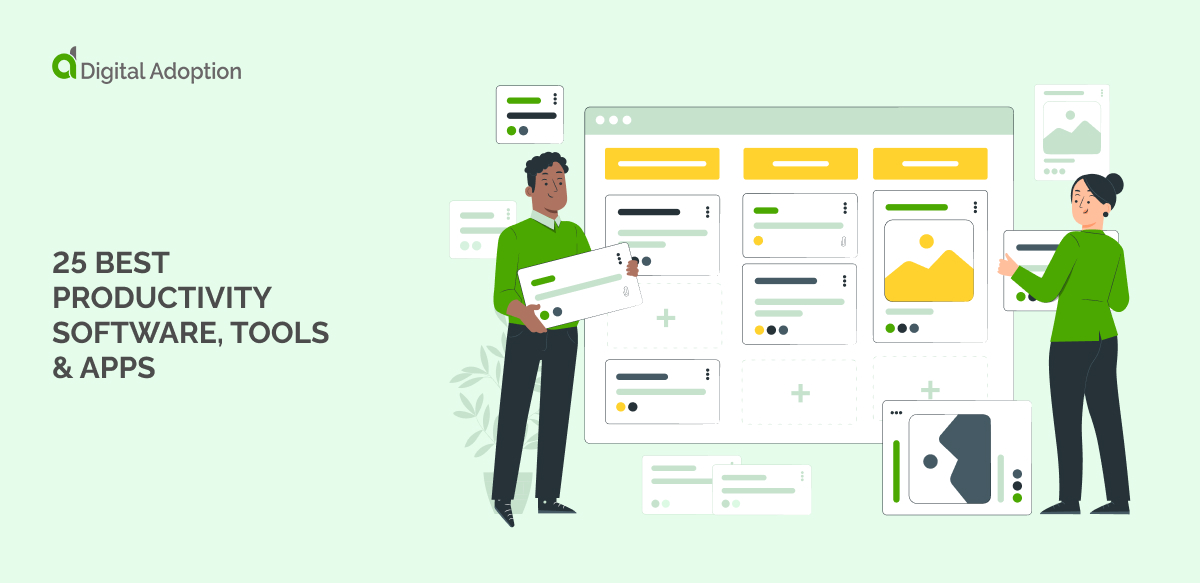The versatile functionalities of productivity software make it indispensable in modern workflow automation and management, orchestrating improved efficiency, where seamless collaboration converges with swift communication, and organizations become the architect of their own success.
According to Statista, the revenue in the Productivity Software market is expected to hit around $79.07 billion in 2024.
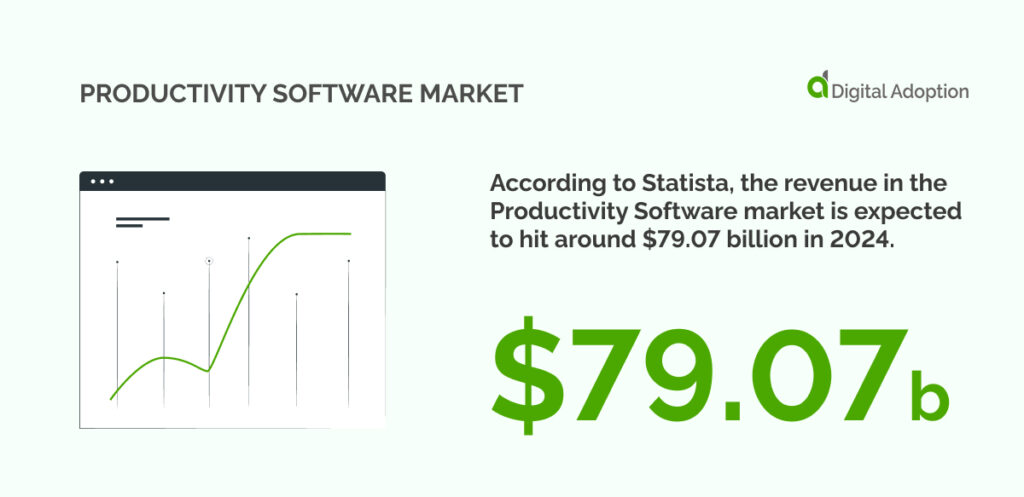
This article explores productivity software, delving into the 25 best tools crucial for modern workflow automation, streamlining tasks, enhancing collaboration, and boosting overall efficiency.
What is productivity software?
Productivity software is a program, tool, or application used to empower users to accomplish tasks, achieve objectives, and unlock productivity capabilities. These productivity tools often encompass a range of functionalities, including creating and editing documents, multimedia, spreadsheets, presentations, managing databases, facilitating communication, and supporting various aspects of workflow management.
Key business functions necessitate using employee productivity tools across teams and departments, including communication, collaboration, project and data management, document creation, and financial oversight.
What are the best productivity software, tools and apps for collaborative teams?
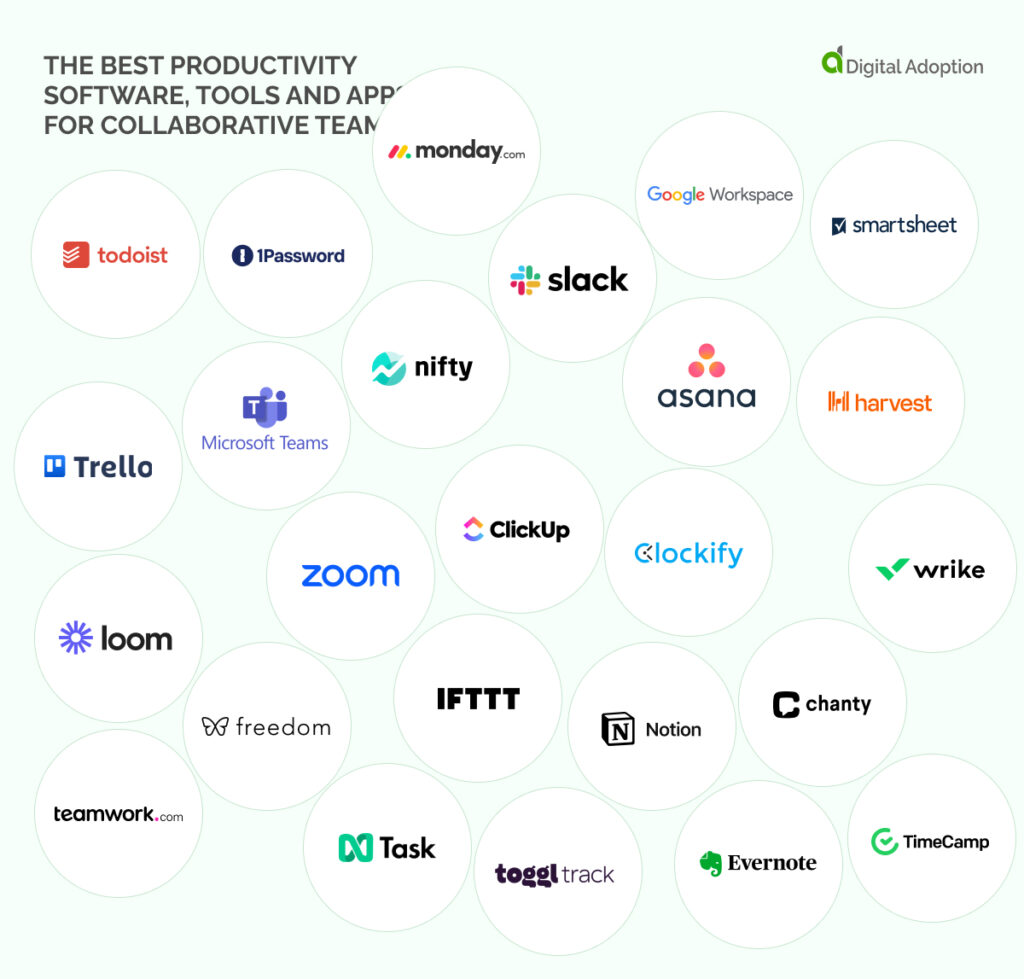
The ways we hit our productivity groove vary from one person to the next. Some thrive on structure, others on flexibility. And that’s where productivity software comes in – the unsung hero keeping teams in sync and workflows running like clockwork.
Our curated list isn’t just a random assortment of apps. It’s a toolkit that caters to different work styles and team dynamics. Whether you’re the visual type who loves to see tasks laid out or the minimalist who thrives on simplicity, there’s something here for everyone.
Review ratings have been taken from G2.com.
Let’s explore how these can elevate workflow management and help cultivate synchronicity across teams.
- Microsoft Teams
- G2 Rating: 4.3/5 (14,648)
- Pricing: $4.80/Month
Microsoft Teams is a robust collaboration platform seamlessly integrated with the Microsoft 365 suite and is widely used across various industries.
This multifaceted tool combines chat, video conferencing, file sharing, and integration capabilities, offering teams a centralized space for efficient communication and project collaboration. Its unique value lies in providing a comprehensive hub where teams can streamline workflows and seamlessly connect with various Microsoft 365 applications.
Features:
- Chat and Messaging: Real-time communication through text messages and multimedia.
- File Sharing and Collaboration: Seamless sharing, editing, and collaboration on documents within the platform.
- Video Conferencing: High-quality video and audio calls for virtual meetings and collaboration.
- Integration with Microsoft 365: Smooth integration with other Microsoft 365 apps and services.
- Customizable: Tailor the platform to your team’s needs with customizable channels, tabs, and app integrations.
Best for: Teams that live and breathe Microsoft 365 and want a no-nonsense space for seamless collaboration.
- Trello
- G2 Rating: 4.4/5 (13,469)
- Pricing: Free, Standard, Premium, and Enterprise options available.
Trello, renowned for its simplicity and versatility, is a visual project management tool designed to clarify team workflows.
Trello transforms project organization into an intuitive and collaborative process by employing boards, lists, and cards. Its distinctive value lies in providing teams with a user-friendly platform that facilitates clear task tracking, fostering transparency and teamwork in project management.
Features:
- Boards and Lists: Organize tasks using boards and lists to visually represent workflows.
- Cards and Details: Break down tasks into cards with detailed information and attachments.
- Collaboration and Comments: Facilitate team collaboration with comments and activity tracking on cards.
- Checklists and Due Dates: Create checklists within cards and set due dates to manage task completion.
- Power-Ups: Enhance functionality with Power-Ups, integrations that extend Trello’s capabilities.
Best for: Teams valuing simplicity and flexibility in project management.
- Slack
- G2 Rating: 4.5/5 (32,267)
- Pricing: Free, Standard, Plus, and Enterprise Grid options available.
Slack is a collaboration tool that transforms team communication through its dynamic messaging system that extends beyond conventional channels.
This tool enables teams to communicate in real-time, share files, and integrate with various third-party apps. Slack’s unique value is its ability to reduce email clutter, offering teams a centralized space for quick and efficient communication, thereby enhancing collaboration.
Features:
- Channels for Communication: Organize conversations into channels for efficient communication.
- Direct Messages: Facilitate private one-on-one or small group conversations.
- File Sharing and Integration: Share files and integrate with various apps for seamless collaboration.
- Notifications and Mentions: Stay updated with notifications and mentions to prioritize important messages.
- Search Functionality: Quickly find and retrieve information with powerful search functionality.
Best for: Teams aiming to boost communication and collaboration without drowning in emails.
- Google Workspace
- G2 Rating: 4.6/5 (42,317)
- Pricing: Business Starter, Business Standard, and Business Plus options available.
Probably the most well-known in this list, Google Workspace is a comprehensive suite of cloud-based productivity tools encompassing familiar applications like Gmail, Google Docs, and Sheets.
Its unique value lies in providing teams with a collaborative ecosystem, allowing real-time editing of documents, seamless email communication, and cloud-based storage.
Features:
- Gmail for Email Communication: Efficient email management and communication.
- Google Drive for File Storage: Collaborative file storage and sharing with real-time editing capabilities.
- Google Docs, Sheets, and Slides: Cloud-based document creation and collaboration.
- Google Meet for Video Conferencing: Seamless video meetings with integrated chat and screen sharing.
- Google Calendar for Scheduling: Easy scheduling and coordination with shared calendars.
Best for: Teams embracing cloud-centric collaboration and document sharing.
- Todoist
- G2 Rating: 4.4/5 (772)
- Pricing: Free, Pro, and Business options available.
Todoist emerges as a versatile task management app, enhancing management capabilities among individuals and teams.
Its functionality revolves around organizing and prioritizing tasks efficiently. The unique value of Todoist lies in its simplicity, offering users an intuitive platform for managing tasks, setting priorities, and ensuring that everyone stays on top of their workload, ultimately enhancing productivity.
Features:
- Task Creation and Organization: Easily create tasks and organize them into lists or projects.
- Due Dates and Reminders: Set due dates and receive reminders to stay on top of deadlines.
- Collaboration and Sharing: Collaborate with others by sharing task lists or assigning tasks.
- Notes and Attachments: Add notes and attachments to tasks for additional details and context.
- Cross-Platform Accessibility: Access tasks and lists from various devices for on-the-go productivity.
Best for: Individuals and teams who want a straightforward tool for task management.
- 1Password
- G2 Rating: 4.7/5 (1,325)
- Pricing: Enterprise, Team Starter, and Business options available.
1Password’s robust password management capabilities prioritize security by providing a secure and efficient solution for safeguarding sensitive information.
It streamlines the management of passwords, ensuring teams can maintain strong and unique credentials effortlessly.
Its unique value lies in enhancing cybersecurity by providing a secure vault for storing sensitive information promoting best practices in password management.
Features:
- Secure Password Management: Safely store and manage passwords in an encrypted vault.
- Two-Factor Authentication (2FA): Enhance security with two-factor authentication for accounts.
- Secure Note Storage: Safeguard sensitive information with secure note storage.
- Password Generator: Create strong, unique passwords with the built-in password generator.
- Cross-Platform Sync: Synchronize passwords and data across multiple devices for accessibility and consistency.
Best for: Teams prioritizing strong cybersecurity practices.
- Nifty
- G2 Rating: 4.7/5 (631)
- Pricing: Free, Starter Pro, and Business options available.
Nifty is a project management platform that integrates tasks, timelines, and communication in one centralized space. It provides teams with a comprehensive overview of projects, enhancing collaboration and productivity.
Features:
- Task and Project Management: Efficiently manage tasks and projects in a centralized workspace.
- Communication Hub: Integrated chat and discussions for seamless team communication.
- File Sharing and Collaboration: Collaborate on documents with real-time editing and file sharing.
- Project Milestones and Timelines: Track project progress with milestones and visual timelines.
- Team Collaboration: Enhance teamwork with features like mentions, comments, and collaborative planning.
Best for: Teams looking for an all-in-one project management solution.
- ClickUp
- G2 Rating: 4.7/5 (9, 240)
- Pricing: Free, Unlimited, Business, and Business Plus options available.
ClickUp is a versatile project management and productivity tool offering a customizable workspace for teams. It integrates tasks, docs, goals, and chat, streamlining collaboration and organization.
Features:
- Task and Project Management: Organize tasks and projects in customizable spaces.
- Collaboration and Communication: Integrated chat, comments, and real-time collaboration on tasks.
- Docs and Note-taking: Create and store documentation within the platform for easy reference.
- Time Tracking and Reporting: Monitor project timelines and generate insightful reports.
- Customizable Workflows: Tailor workflows and views to match your team’s specific needs for efficient task management.
Best for: Teams seeking flexibility and customization in project management.
- Clockify
- G2 Rating: 4.5/5 (160)
- Pricing: Basic, Standard, Pro, and Enterprise options available.
Clockify is a time-tracking tool designed to assist teams in monitoring project timelines, tracking work hours, and optimizing resource utilization.
Features:
- Time Tracking and Reporting: Efficiently track time spent on tasks and generate detailed reports.
- Project and Task Management: Organize work into projects and tasks for streamlined tracking.
- User-Friendly Interface: Intuitive interface for easy navigation and seamless time entry.
- Client Billing and Invoicing: Facilitate client billing by accurately tracking billable hours.
- Cross-Platform Accessibility: Access time tracking data across various devices for convenience.
Best for: Teams focused on optimizing time management and project efficiency.
- Loom
- G2 Rating: 4.4/5 (1,840)
- Pricing: Starter, Business, and Enterprise options available.
Loom is a video messaging tool that empowers teams to communicate and collaborate through video recordings. It provides an efficient way to share information and feedback visually.
Features:
- Video Messaging: Easily create and share video messages for effective communication.
- Screen Recording: Capture and share screen recordings with added voiceover.
- Instant Sharing and Collaboration: Seamlessly share videos for quick collaboration and feedback.
- Viewer Analytics: Track viewer engagement and analytics for shared videos.
- Cross-Platform Compatibility: Access and share videos across different devices and platforms for flexibility.
Best for: Teams prioritizing visual communication and feedback.
- Freedom
- G2 Rating: 5/5 (49)
- Pricing: Starter, Business, and Enterprise options available.
Freedom is a productivity app designed to help individuals and teams manage digital distractions by blocking websites and apps. It fosters focus and enhances productivity.
Features:
- Website and App Blocking: Restrict access to distracting websites and apps.
- Scheduled Focus Sessions: Plan focused work sessions with customizable schedules.
- Device Syncing: Synchronize preferences and schedules across multiple devices.
- Detailed Usage Reports: Track and analyze device usage for insights into productivity.
- Distraction-Free Work Environment: Foster concentration by eliminating digital distractions.
Best for: Teams and individuals looking to increase focus and minimize distractions.
- Monday.com
- G2 Rating: 4.7/5 (10,377)
- Pricing: Basic, Standard, Pro, and Enterprise options available.
Monday.com is an intuitive work operating system where teams can manage projects, workflows, and collaboration in one centralized platform.
Features:
- Visual Project Management: Manage tasks and projects with customizable and visual boards.
- Collaboration and Communication: Integrated communication tools for team collaboration.
- Workflow Automation: Automate repetitive tasks and streamline workflows for efficiency.
- Customizable Dashboards and Views: Tailor dashboards and views to suit specific project needs.
- Integrations and Apps: Connect with third-party apps to enhance functionality and workflow integration.
Best for: Teams of all sizes seeking a flexible, visual project management solution.
- Asana
- G2 Rating: 4.3/5 (9,608)
- Pricing: Free, Starter, Advanced, and Enterprise options available.
Asana is a leading project management and collaboration tool, serving as a dynamic platform designed to empower teams to orchestrate their work with precision and efficiency.
Functioning as a centralized hub for project organization, task tracking, and team communication, Asana revolutionizes how teams collaborate on projects, ensuring clarity, accountability, and seamless coordination.
Asana delivers a visual and intuitive workspace that allows teams to plan, execute, and monitor tasks with unparalleled ease, facilitating a collaborative environment that fast-tracks productivity.
Features:
- Task and Project Management: Organize and track tasks and projects with flexibility.
- Collaboration and Communication: Facilitate team communication with comments and updates.
- Project Timelines and Portfolios: Visualize project timelines and manage portfolios for comprehensive planning.
- Task Assignments and Due Dates: Assign tasks, set due dates, and monitor project progress efficiently.
- Integrations and App Ecosystem: Connect with various apps and integrations to enhance workflow capabilities.
Best for: Teams of all sizes seeking a flexible, visual project management solution.
- IFTTT
- G2 Rating: 4.6/5 (111)
- Pricing: Free, Pro, and Pro Plus options available.
If This Then That (IFTTT) redefines automation by offering users a versatile and user-friendly platform to create customized connections between various apps and devices.
IFTTT operates on the principle of triggering actions based on specific conditions, allowing users to automate repetitive tasks effortlessly. It can bridge the gap between diverse applications, enabling users to streamline their digital workflows by automating routine actions and creating seamless harmony between different tools—ultimately saving time and boosting productivity.
Features:
- Customizable Applets: Create personalized automated workflows with “if this, then that” logic.
- Wide Range of App Integrations: Connect and automate actions across a diverse set of apps and devices.
- Automation Triggers and Actions: Set up triggers and actions to automate routine tasks.
- Cross-Platform Compatibility: Access and control automated processes across various devices and platforms.
- Applet Sharing and Community: Share and discover custom applets within the IFTTT community for expanded automation possibilities.
Best for: Users looking to automate routine tasks and create seamless digital workflows.
- Smartsheet
- G2 Rating: 4.4/5 (14,355)
- Pricing: Free, Pro, Business, and Enterprise options available.
Smartsheet stands as a powerful work execution platform, combining the flexibility of spreadsheets with collaborative project management features.
It empowers teams to seamlessly plan, track, automate, and report on work. It offers versatile solutions for addressing project management needs, allowing teams to create dynamic sheets, automate workflows, and collaborate in real time, helping to enhance project transparency and accelerate work execution.
Features:
- Grid-Based Task and Project Management: Organize and track tasks and projects in a familiar spreadsheet-style layout.
- Collaboration and Comments: Foster teamwork with integrated communication and comments on tasks.
- Automations and Workflows: Streamline processes through automated workflows for efficiency.
- Resource Management: Allocate and manage resources effectively for optimized project execution.
- Reporting and Dashboards: Generate insightful reports and visual dashboards for comprehensive project analysis.
Best for: Teams with diverse project management needs seeking a collaborative platform.
- Harvest
- G2 Rating: 4.3/5 (794)
- Pricing: Free, Pro Monthly, and Pro Annual options available.
Harvest is a comprehensive time-tracking and invoicing tool addressing the critical aspects of time management and financial tracking for individuals and teams alike.
It facilitates precise time tracking, expense management, and efficient invoicing, providing valuable insights into project profitability. It simplifies the often intricate processes of time tracking and billing, allowing teams to focus on their work while ensuring accurate billing and financial clarity.
Features:
- Time Tracking and Expense Management: Accurately track time and manage expenses for projects.
- Invoicing and Payments: Create and send professional invoices and track payment status.
- Project and Team Collaboration: Collaborate on projects with features like task assignments and project budgets.
- Reporting and Analytics: Generate detailed reports for insights into time and project performance.
- Integration with Third-Party Tools: Connect with other apps for seamless workflow integration.
Best for: Teams and individuals focusing on time management and project financials.
- Wrike
- G2 Rating: 4.2/5 (3,514)
- Pricing: Free, Team, Business, and Enterprise options available.
Wrike is a project management and collaboration solution designed to streamline workflows and drive team productivity.
With features spanning task management, real-time collaboration, and project planning, Wrike provides a centralized space for teams to coordinate their efforts. Its adaptive structure accommodates various work styles and project types, making it a valuable asset for teams seeking a customizable yet powerful project management solution.
Features:
- Task and Project Management: Organize and track tasks and projects with a flexible and dynamic structure.
- Real-Time Collaboration and Communication: Facilitate team communication through live editing and commenting.
- Customizable Workflows and Dashboards: Tailor workflows and dashboards to match specific project requirements.
- Time Tracking and Reporting: Monitor project progress and generate detailed time-related reports.
- Integration with External Tools: Seamlessly connect with third-party apps and tools for enhanced functionality.
Best for: Teams seeking flexibility and adaptability in project management.
- Notion
- G2 Rating: 4.7/5 (5,037)
- Pricing: Free, Plus, Business and Enterprise options available.
Notion is hailed as an all-in-one workspace, surpassing traditional productivity tools by integrating note-taking, task management, and collaboration features into a singular platform.
This versatile tool is a dynamic workspace where teams can document, plan, and collaborate seamlessly. It provides a unified environment that adapts to diverse workflows, allowing teams to centralize their work, share knowledge, and foster collaborative creativity in a single, accessible space.
Features:
- Flexible Content Organization: Organize notes, tasks, and projects in a customizable workspace.
- Collaboration and Comments: Facilitate team collaboration with real-time editing and commenting.
- Knowledge Base and Wiki: Create a centralized knowledge base for information sharing.
- Database and Project Management: Build databases and manage projects with versatile tools.
- Cross-Platform Accessibility: Access and collaborate on content across various devices for seamless productivity.
Best for: Teams seeking an all-encompassing workspace for diverse tasks.
- Teamwork
- G2 Rating: 4.4/5 (1,073)
- Pricing: Free, Starter, Deliver, and Grow options available.
Teamwork is a robust project management and collaboration platform that empowers teams to plan, track, and execute tasks precisely.
It provides a comprehensive suite of tools, including project planning, task management, and document sharing, fostering efficient collaboration among team members.
Features:
- Task and Project Management: Organize and track tasks and projects with a collaborative approach.
- Team Collaboration and Communication: Integrated tools for effective team communication and collaboration.
- File Sharing and Document Management: Share files and manage documents within the platform.
- Time Tracking and Resource Management: Track time spent on tasks and manage project resources efficiently.
- Project Reporting and Analytics: Generate reports and analyze project data for insights and performance evaluation.
Best for: Teams looking for an integrated project and task management platform.
- Chanty
- G2 Rating: 4.5/5 (40)
- Pricing: Free and Business options available.
With features like team chat, task management, and file sharing, Chanty aims to streamline communication and enhance team productivity.
Features:
- Messaging and Team Communication: Real-time messaging for efficient team communication.
- Task Management: Organize tasks and projects with shared to-do lists.
- File Sharing and Collaboration: Collaborate on documents and share files within the platform.
- Integrations with Third-Party Tools: Connect with other apps for seamless workflow integration.
- Search and Archive Functionality: Easily find and retrieve information with robust search and archive features.
Best for: Teams looking for an easy-to-use collaboration platform with integrated chat.
- nTask
- G2 Rating: 4.4/5 (17)
- Pricing: Basic, Business, and premium options available.
nTask is a comprehensive project management tool that combines task management, issue tracking, and meeting scheduling. It provides a centralized platform for teams to plan, execute, and monitor projects, fostering collaboration and efficient task management.
Features:
- Task and Project Management: Organize tasks and projects with a user-friendly interface.
- Team Collaboration and Communication: Facilitate communication through comments and task discussions.
- Time Tracking and Reporting: Track time spent on tasks and generate insightful reports.
- Issue Tracking and Risk Management: Identify and manage project issues and risks efficiently.
- Integration with Calendar and Email: Sync tasks with calendars and integrate with email for enhanced productivity.
Best for: Teams seeking an all-in-one solution for project and task management.
- Toggl
- G2 Rating: 4.6/5 (1,557)
- Pricing: Basic, Business, and premium options available.
Toggl is a time-tracking and productivity tool that enables users to monitor and analyze how they spend their time. With features like time tracking, reporting, and team collaboration, Toggl aims to enhance time management and productivity.
Features:
- Time Tracking and Reporting: Accurately track time spent on tasks and projects.
- Project and Client Tracking: Organize time entries by project and client for efficient management.
- User-Friendly Interface: Intuitive design for easy time entry and navigation.
- Cross-Platform Accessibility: Access and sync time tracking data across various devices.
- Integration with Other Tools: Connect with external apps and tools to streamline workflows and enhance productivity.
Best for: Individuals and teams focused on optimizing time usage and productivity.
- Zoom
- G2 Rating: 4.6/5 (54, 173)
- Pricing: Free, Pro, Business, and Enterprise options available.
Zoom is a widely used video conferencing and collaboration platform known for its seamless video communication and virtual meeting capabilities. It provides a reliable solution for remote communication and team collaboration.
Features:
- High-Quality Video Meetings: Conduct virtual meetings with clear audio and video quality.
- Screen Sharing and Collaboration Tools: Facilitate collaboration through screen sharing and interactive tools.
- Webinars and Large Meetings: Host webinars and large-scale virtual meetings with ease.
- Chat and Messaging: Instant messaging for quick communication during meetings.
- Cross-Platform Compatibility: Access and join meetings from various devices for flexibility.
Best for: Teams engaging in remote collaboration and virtual meetings.
- TimeCamp
- G2 Rating: 4.7/5 (194)
- Pricing: Free, Starter, Ultimate, and Premium options available.
TimeCamp is a time-tracking and productivity solution designed to help individuals and teams monitor their work hours, analyze productivity, and optimize time management. With features like automatic time tracking and productivity analysis, TimeCamp aims to enhance overall work efficiency.
Features:
- Automatic Time Tracking: Seamlessly track time spent on tasks and projects without manual input.
- Project and Task Management: Organize work with a comprehensive project and task hierarchy.
- Attendance and Leave Tracking: Monitor attendance and manage leave requests within the platform.
- Invoicing and Billing Integration: Generate invoices based on tracked time for accurate billing.
- Reporting and Analytics: Access detailed reports and analytics for insights into time utilization and project performance.
Best for: Teams and individuals focused on time optimization and productivity analysis.
- Evernote
- G2 Rating: 4.4/5 (2,008)
- Pricing: Free, and Premium options available.
Evernote is a comprehensive note-taking and organization tool that helps individuals and teams capture ideas, organize information, and collaborate on projects.
With features like note-taking, document scanning, and team collaboration, Evernote aims to centralize information and streamline collaboration.
Features:
- Note Creation and Organization: Create and organize notes with a user-friendly interface.
- Cross-Platform Syncing: Sync notes across various devices for accessibility.
- Tagging and Categorization: Organize notes efficiently with tags and categories.
- Web Clipping and Content Capture: Clip and save web content for reference within the platform.
- Search Functionality: Easily find and retrieve information through powerful search features.
Best for: Teams seeking an organized and collaborative note-taking solution.
What makes productivity software essential?
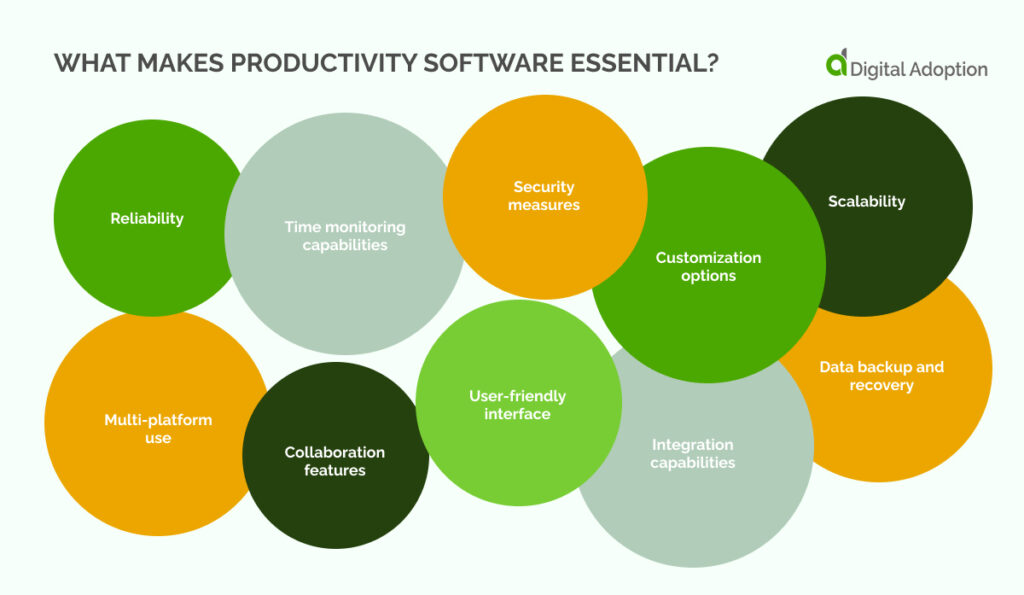
Whether you’re seeking the flexibility of cloud-based options like Google Workspace and Microsoft’s OneDrive, or you lean towards the rock-solid reliability of on-premise solutions like Oracle Database or Adobe Acrobat, choosing productivity software comes down to what suits your team, data transformation needs, and overarching organizational priorities.
Cutting corners in this realm, particularly when protecting critical company data, can lead to unreliable systems, compromised security, and hindered productivity.
However eager to benefit from the current digital disruption, increasing software investments requires a thoughtful approach on behalf of CIOs and CFOs across sectors, especially when considering the tech qualities essential for modern businesses to survive.
To gain a better understanding, let’s evaluate key components that are typically associated with productivity software.
These essential elements should include:
- Reliability – Ensuring steadfast performance is imperative for maintaining seamless operations and mitigating disruptions.
- Time monitoring capabilities – Efficient time management tools are crucial for optimizing productivity and ensuring effective resource utilization.
- Multi-platform use – Cross-device compatibility is essential for fostering flexibility and accessibility in the evolving landscape of modern workplaces.
- Collaboration features – Robust collaboration tools enhance teamwork, communication, and project efficiency.
- Security measures – Prioritizing software with robust security features is non-negotiable to safeguard sensitive data and adhere to privacy standards.
- User-friendly interface – An intuitive design is vital to ease the learning curve, ensuring quick adoption by your team and maximizing software utilization.
- Customization options – Tailoring software to meet specific organizational needs and workflows is key for optimizing its utility within your unique business context.
- Integration capabilities – Seamless integration with other tools and applications creates a seamless work environment, enhancing overall efficiency.
- Scalability – Choosing scalable software ensures adaptability to your organization’s growth without compromising performance.
- Data backup and recovery – Robust data backup and recovery mechanisms are fundamental to prevent loss and ensure business continuity in unforeseen circumstances.
Taking a measured approach to these qualities in productivity software investments not only safeguards the integrity of your operations but also paves the way for enhanced collaboration, security, and overall business success.
How to choose the right productivity software
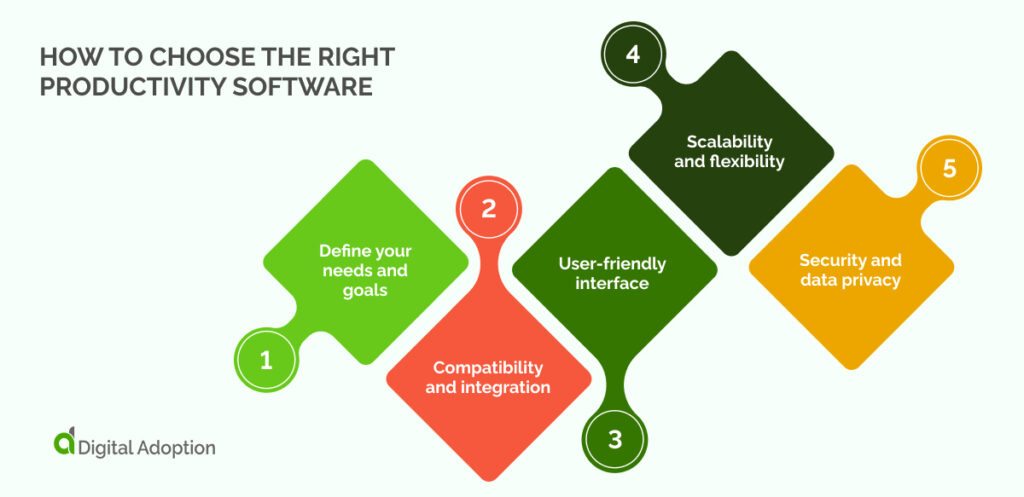
Selecting the right productivity software is crucial as it significantly enhances efficiency, streamlines workflows, and facilitates effective collaboration, ultimately contributing to overall organizational or individual success.
Let’s take a closer look:
Define your needs and goals
Begin by identifying your specific productivity needs and goals.
Consider the nature of your work, the tasks you regularly perform, and the challenges you face. Determine if you need software for project management, time tracking, collaboration, note-taking, or a combination of these functionalities. Clarifying your requirements will help you focus on software that aligns with your objectives.
Compatibility and integration
Evaluate the compatibility and integration capabilities of the productivity software with your existing tools and workflow.
Ensure that the software seamlessly integrates with your commonly used applications, such as email clients, calendars, or file storage systems. Compatibility is crucial for a smooth transition and efficient collaboration across different platforms.
User-friendly interface
Choose productivity software with an intuitive and user-friendly interface.
A well-designed interface enhances user adoption and reduces the learning curve, allowing you and your team to quickly grasp how to use the software effectively. Look for features like customizable dashboards, straightforward navigation, and a clean design that promotes ease of use.
Scalability and flexibility
Consider the scalability and flexibility of the productivity software to accommodate your growing needs.
Opt for a solution that can scale with your business or personal demands, providing room for expansion without compromising performance. Additionally, assess the flexibility of the software in terms of customization and adaptability to different work styles, ensuring it can cater to your evolving requirements.
Security and data privacy
Prioritize the security and data privacy features of the productivity software.
Verify that the software employs robust encryption methods, offers secure access controls, and complies with industry standards for data protection. Understanding how the software handles sensitive information is crucial, especially when dealing with confidential data or collaborating on projects involving sensitive details. Choose a solution that aligns with your security requirements and adheres to relevant regulations.
Following the above steps enables you to systematically evaluate and select the productivity software that best suits your needs, ensuring a more efficient and streamlined approach to your work.
What are the benefits of productivity software?
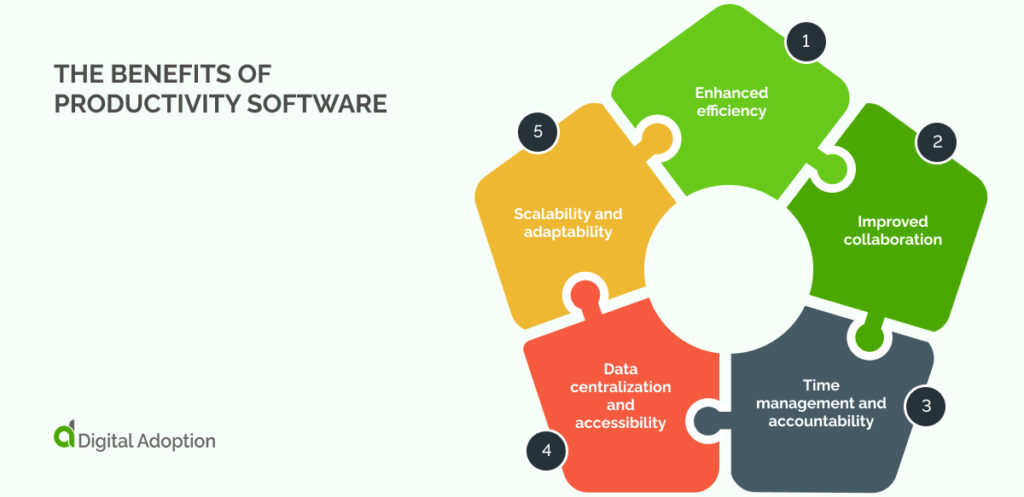
Businesses that grasp the benefits of diverse productivity software tools are often empowered to make informed choices, fostering an agile and optimized operational environment essential for staying competitive and achieving sustained success.
Let’s take a closer look at the benefits:
Enhanced efficiency
Productivity software automates repetitive tasks, streamlines workflows, and optimizes processes, leading to increased efficiency and reduced manual effort. This efficiency boost allows employees to focus on more strategic and value-added activities.
Improved collaboration
Many productivity tools provide collaborative features, enabling team members to work seamlessly together, regardless of their physical locations. Real-time document sharing, project management, and communication tools foster teamwork and enhance collective productivity.
Time management and accountability
Productivity software often includes features for time tracking, task management, and goal setting. This helps employees manage their time effectively, prioritize tasks, and stay accountable for deadlines, contributing to better overall time management within the organization.
Data centralization and accessibility
Centralized data storage and accessibility are key benefits of productivity software. Storing information in a unified platform ensures that relevant data is easily accessible to authorized personnel, reducing the risk of data silos and enhancing the organization’s ability to make informed decisions.
Scalability and adaptability
Productivity software can scale alongside the growth of a business, accommodating increased workloads and evolving needs. Whether expanding the team, taking on more projects, or adapting to new processes, the right productivity tools provide the flexibility to support the organization’s growth and adjust to changing circumstances.
Productivity software: What’s next?
Productivity software propels businesses into a juncture where strategic decisions shape the trajectory of efficiency, collaboration, and overall success.
As the digital workplace evolves, selecting the right tools becomes empowering, unleashing the potential for transformative workflows and streamlined operations.
Embracing the right productivity software calls for bold choices and strategic investments tailored to unique organizational needs. The next steps involve meticulously examining functionalities, seamless integrations, and scalability potentials.
Businesses are urged to envision productivity software as tools and catalysts for innovation and growth.
With a myriad of options at their disposal, the power lies in making informed, fearless decisions that align with the company’s vision.

